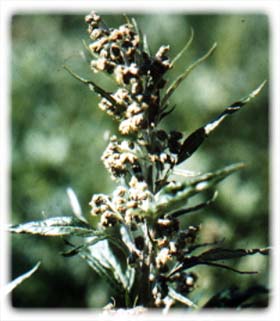Leaves
|
|||||||||||||||||
|
|
|
||||||||||||||||

The plant is found every where in Golovin.
Charighik is in the Composite family and
has very small heads that contain many flowers on one head.
These heads are yellowish but are not as distinct as the
leaves. The large leaves are deeply lobed and have a
silvery-green color. The distinctive aroma of
charighik has given it the nickname,
"stinkweed". I don't find the smell unpleasant but it has
earned the nickname stinkweed, none the less. One of the
village women, Laura Esparza, told me she rubbed
charighik leaves all over her hands after
she had butchered a walrus to take away the smell. So there
are benefits to the odor of stinkweed.
Charighik is a useful medicinal plant that virtually everyone in Golovin knows about. Fewer people actually use the plant to help cure colds, skin problems, and any wounds, but I heard many stories of it's miracle curing abilities. My grandma told me one story about when my father, Ronald Punguk, was young. They had a fish camp at Council, Alaska, 40 miles up the Fish River, from Golovin. While Ronnie was preparing fish to dry, he cut himself between his fore finger and middle finger. My Grandpa Ralph put charighik in the cut and it healed in just a few days.
|
a description by Florence Willoya |
|
Stinkweed is found in dry areas with many other plants. It usually grows in clusters. When the weed turns brown it is picked and made into a medicine. Sometimes the weed is boiled about 10 minutes and brewed into a drink which a person feeling poorly drinks. This cleans out the stomach and system. Sometimes the weed is made to put on an infected area. The leaves are rubbed back and forth in the hands until they are as soft as cotton, then put directly on the infection. This is left for about twenty four hours. Then changes again and again until the affected area is healed. The stinkweed is used today by the older Eskimos to help them get well. It is now used only when no other medication can help the sick person. It is no longer used by young people; they would rather go to a doctor for medicine. Stinkweed has an unpleasant smell and they taste strong but they certainly can help a very sick person get well. |
To make tea: gather dried stems of charighik. The leaves should be dry and crisp to the touch. Remove the leaves and boil them in water for about 10 minutes. Drink the liquid to help fight colds, flu, and other ailments. To make poultice: rub the dry leaves to make a cottony material, then mix with vaseline to apply to the wound or skin sores. Maggie mentioned that people even used to put the dry leaves directly on the chest of a person with a cold, it acts like Vics vapor rub. The plant is also useful as an insect repellent. The green leaves can be burned in a fire to keep flies and other insects off hanging fish on the rack. You can also rub the green leaves over exposed skin and to keep mosquitoes and gnats from bothering you. My Grandma Florence said that people also prepare bath water with charighik mixed in and this is good to relieve arthritis pain.